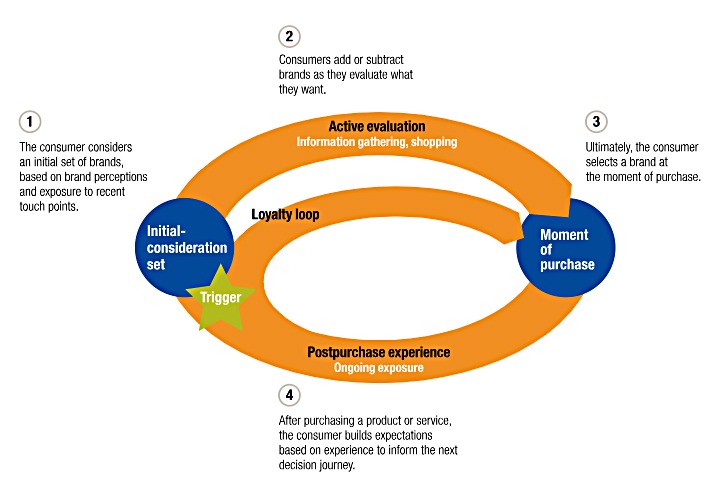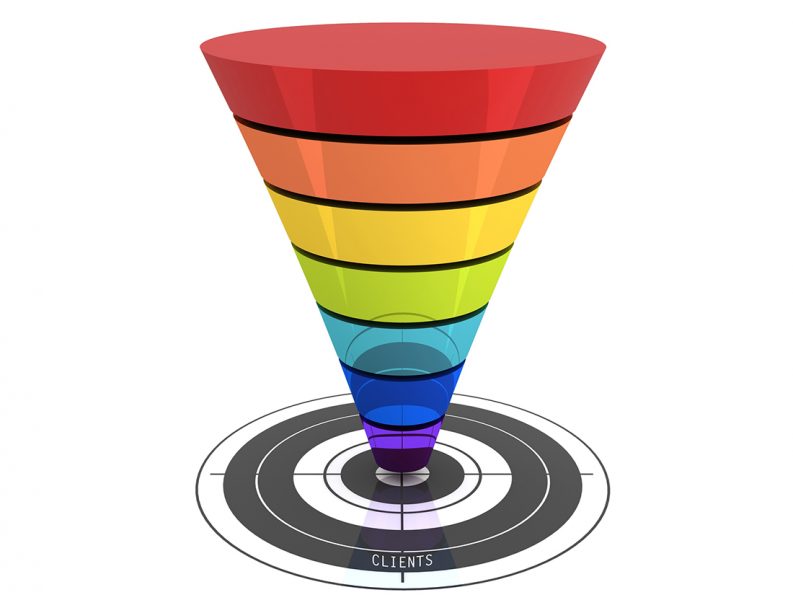In traditional marketing, that is, before e-commerce set marketing on its ear, a marketing funnel (aka purchase funnel or sales funnel) was a term used to define the path and stages by which a potential customer moved from awareness of your brand or product to purchase. Visually represented as an upside-down funnel, the stages of the marketing funnel were known by the acronym AIDA: Awareness, Interest, Desire, Action.
Put simply, at the top of the marketing funnel, potential customers became aware of your product or service; in the middle of the funnel you drove them closer to conversion with incentives or new ads; and at the bottom of the funnel, they converted into customers. Each step in the funnel (then and now) reduced the number of potential customers, typically by 30%–80%.
But the introduction of e-commerce and the ability to search online with a mobile device at any time changed the shape of the marketing funnel. As a result, the new digital marketing funnel path is anything but funnel-shaped.
The marketing funnel pre-internet
Back in the “good old days” of marketing, brands used mass media to create awareness of products and services. Pushing customers through the sales funnel was a somewhat linear path and in retrospect, far simpler.
The primary levers of the traditional marketing funnel were reach and frequency:
- Identify your potential customer
- Create advertisements targeted to them
- Buy print, billboards, radio, and TV in sufficient frequency to get the job done.
The digital marketing funnel is a less linear and more sophisticated approach. Its purpose is to move customers from awareness to purchase of course, but adds the additional stage of customer retention. Mass media still plays a role for larger brands, but for SMB’s who rely solely on digital marketing, an effective online marketing funnel is critical. Email marketing, website user experience, content strategy, digital ads, and social media all play a role. Companies now have the opportunity to take advantage of the many additional touchpoints offered by digital channels to reach well-informed consumers who live online.
With those digital touchpoints, the path to conversion no longer looks like that upside down funnel. As no two people search for or research the same product in the same way, the digital marketing funnel path to conversion may look like a diamond, a pyramid, an hourglass, a square or many other shapes. Search intent has completely reshaped the marketing funnel and it is no longer a linear customer journey.
A non-linear digital marketing funnel offers more opportunity
This new online marketing funnel shape actually creates new opportunities for SMB’s. Because a buyer moves through the funnel in many different ways, you now have the opportunity to engage them at nearly any point in their customer journey. But this takes considerable planning, a smart content strategy, and analysis of data to determine success.
With the emphasis on mobile search, SMB’s have an opportunity to build awareness of their products or services at the early stages of the customer journey. White papers, blog posts, case studies, product descriptions, social media campaigns, 3rd party posts, and other content marketing strategies can be employed to target users at different stages of the funnel.
A consumer or B2B buyer’s route to purchase is now more circular as they initially research brands or products, evaluate the information, research their potential purchase and then finally make that purchase. Additionally, marketers have to consider post-purchase as consumers experience your brand – what will they say about it? Who will they rave or complain to? Will they buy again?

Digital Marketing Funnel path
In later posts, we’ll discuss the best strategies for each step of the digital marketing funnel.
Want to have a chat about how we can help your marketing conversions? Get in touch with us here.

